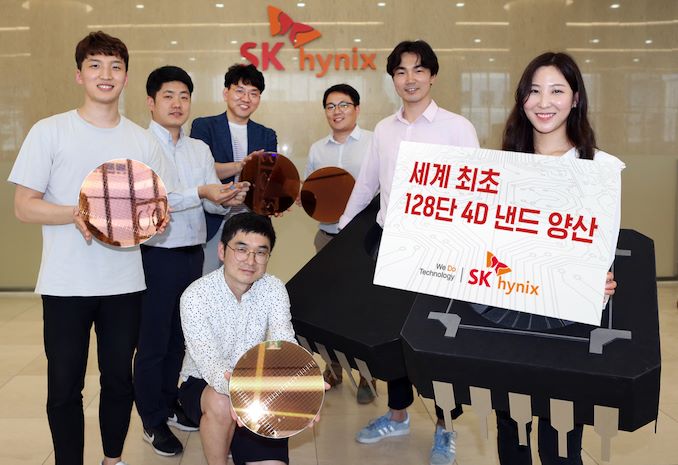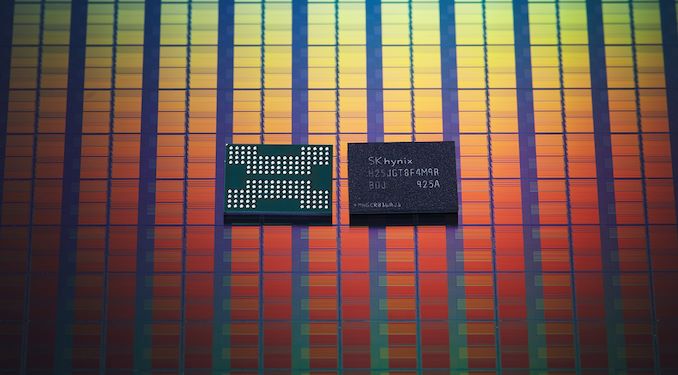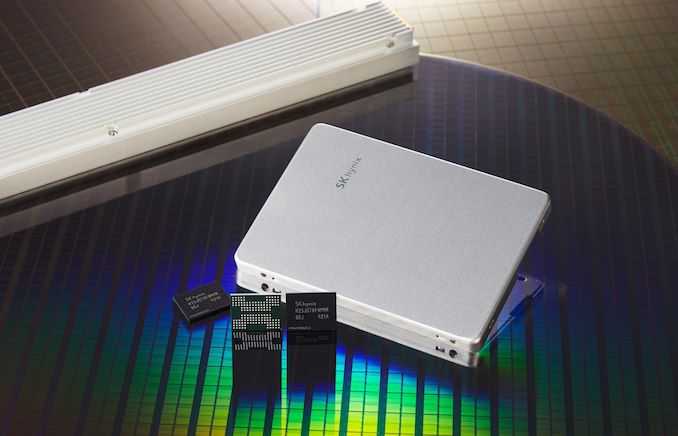SK Hynix Starts Production of 128-Layer 4D NAND, 176-Layer Being Developed
by Anton Shilov on June 26, 2019 8:00 AM EST
SK Hynix has announced it has finished development of its 128-layer 1 terabit 3D TLC NAND flash. The new memory features the company’s charge trap flash (CTF) design, along with the peripheral under cells (PUC) architecture that the company calls ‘4D’ NAND, announced some time ago. The new 128-layer TLC NAND flash devices will ship to interested parties in the second half of this year, and SK Hynix intends to offer products based on the new chips in 2020.
1 Tb 128-Layer ‘4D’ TLC NAND
SK Hynix’s 1 Tb 128-layer TLC NAND chip features four planes as well as a 1400 MT/s interface at 1.2 Volts. The quad-plane architecture along with a 1400 MT/s I/O bus will make the new TLC NAND devices not only significantly denser (in terms of Gb per mm2) than previous-generation products, but also at least 16% faster. In fact, real-world performance increase could be even higher as SK Hynix once said that its CTF design would enable a faster program time (tPROG) as well as a faster read time (tR).
To stack 128 layers inside its 6th Generation 3D NAND chips, the company had to use a multi-stacked design along with numerous new technologies, including ultra-homogeneous vertical etching technology as well as high-reliability multi-layer thin-film cell formation technology. Meanwhile, to increase performance of the I/O bus without increasing power consumption of the device, SK Hynix implemented its ultra-fast low-power circuit design.
It is noteworthy that transition to CTF + PUC architecture, along with various optimizations, enabled SK Hynix to reduce the number of process steps by 5% as well as increase bit productivity per wafer by 40% when compared to 96-layer TLC NAND. As a result, we should expect to see the new NAND run through the entire product lineup in due course.
Various Applications
SK Hynix and its partners will use the company’s 1 Tb 128-layer TLC NAND chip for a variety of applications.
“SK Hynix has secured the fundamental competitiveness of its NAND business with this 128-Layer 4D NAND,” said Executive Vice President Jong Hoon Oh, head of global sales & marketing. “With this product, with the industry’s best stacking and density, we will provide customers with a variety of solutions at the right time.”
Initial 1 Tb 128-layer TLC NAND chips that SK Hynix will start shipping in the second half of the year will be used primarily for mobile storage devices, such as USB drives and memory cards.
In the first half of next year SK Hynix promises to roll out its UFS 3.1 storage products based on the new 1 Tb devices. The company plans to offer 1 TB UFS 3.1 chips that will consume up to 20% less when compared to similar products that use 512 Gb ICs.
Later in 2020, SK Hynix intends to offer 2 TB client SSDs based on its own controller, as well as 16 and 32 TB server SSDs for datacenters ,.
176-Layer 4D NAND Incoming
String stacking technology, as well as the multi-stacked design, will enable SK Hynix to keep increasing the number of layers. SK Hynix says that it is currently developing 176-layer 4D NAND flash, but does not disclose when it is expected to become available.
Related Reading
- Flash Memory Summit 2018, SK Hynix Keynote Live Blog: NAND Development
- SK Hynix Begins Sampling of 96-Layer 1 Tb 3D QLC NAND
- SK Hynix Launches 96-Layer 3D NAND and Discloses QLC Plans
- SK Hynix Announces SSDs with 72-Layer 3D NAND ICs, Own Controllers
- SK Hynix Launches 2nd Gen Enterprise SSD: 72-Layer 3D NAND & In-House Controller
Source: SK Hynix












28 Comments
View All Comments
nandnandnand - Wednesday, June 26, 2019 - link
Call it "3D NAND" please, not their awful marketing term.melgross - Wednesday, June 26, 2019 - link
That’s your entire response, you don’t like the name?nandnandnand - Wednesday, June 26, 2019 - link
What else needs to be said? It's an incremental and inevitable improvement.haukionkannel - Wednesday, June 26, 2019 - link
Because next we will get 5D and after that 6D and so on... so yeah... stupid Name...in general terms 3D means 3 dimensional, 4 means 3D plus time, so unless this nand send info before anyone ask and gives old info from time to time instead of new info or todays info then 4D is pure missleading advertising...
philehidiot - Wednesday, June 26, 2019 - link
5D is where it's at. This will send electrons to their proper place via the qwantum vacoom and as a result will bring back zero point energiiiieeee which will fuel the PC with freeee powaaaaar. This simple improvement to the functioning of RAM will put sheep out of business and also take the world off dinosaur squeezings as we'll make our own poooowwwaaaarrrrr.My spell checker just had a stroke. My brain actually struggled to write that crap. I'm too sober.
Ithaqua - Wednesday, June 26, 2019 - link
Quick get philehidiot a 6D beer!Kevin G - Thursday, June 27, 2019 - link
4D could simply be leveraging time crystals into the data structure. Though at this scale, I don't that that would be possible and achieve a density improvement.Mikewind Dale - Thursday, June 27, 2019 - link
I want NAND that sends me info before I ask for it! In fact, I really want it to send me data before I've even downloaded it. As an academic, it would really help my career if I could get economic data before the events even happen.linuxgeex - Thursday, June 27, 2019 - link
4D is not an implausible name. XYZ structurally and then quad-level data per cell is 4 dimensions. But they sure as hell better not call the next process 5D, cuz there's sure as hell no 5th dimension they can imply.FunBunny2 - Thursday, June 27, 2019 - link
" there's sure as hell no 5th dimension they can imply."if your a baby boomer, there sure is.